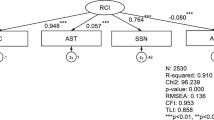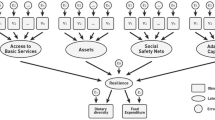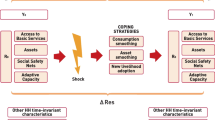Abstract
Uganda continues to be prone to climate shocks especially drought which has adverse impact on food security. This paper studies household resilience capacities with special focus on how different resilience capacities mitigate the impact of drought on food security. The study follows the TANGO framework to identify resilience components, and two-step factor analysis to construct three resilience capacity indexes (absorptive, adaptive, and transformative) and overall resilience capacity index. To examine the mitigating role of resilience capacities, we interact resilience capacity indexes with the different measures of drought. The study employs a panel data from the Uganda National Panel Surveys (UNPS) undertaken between 2010/11 and 2018/19, spanning five waves. To minimise the bias arising from subjective self-reported drought shock, we introduce an objective measure of drought from the global SPEI database into the UNPS data. We also address attrition bias by controlling for attrition hazard estimated from the attrition function. Our analysis reveals that households in Uganda exhibit significantly low and nearly static resilience capacities. This implies majority of households in Uganda remain highly vulnerable to food insecurity in the event of severe drought. The study shows that building resilience capacities is an effective way of protecting households from such devastating situation. Whereas there are mixed results on the effectiveness of different resilience capacities in mitigating the effects of drought depending on the measure of food security and drought, decomposition of each of the three resilience capacities reveals critical aspects in each capacity. Succinctly, access to climate related information and linking social capital are very critical under adaptive capacity, infrastructure services are very key under transformative capacity, while informal safety nets are critical under absorptive capacity. Therefore, interventions that enhance households’ access to the above aspects are very important in building resilience to shocks, especially drought.




Similar content being viewed by others
Notes
Drylands make up about 43 percent of the continent’s land surface, account for about 75 percent of the area used for agriculture, and are home to about 50 percent of the population (Raffaello & Michael, 2016).
Disaster risk finance (DRF) is a component of the governements’ Third Northern Uganda Social Action Fund (NUSAF III) project, that seeks to build the resilience against shocks mainly drought of poor and vulnerable households in northern Uganda by providing income support in the form of labor-intensive public works (LIPW).
The Inter-Governmental Panel Climate Change (IPCC) (2012) defined drought as “a period of abnormally dry weather, long enough to cause a serious hydrological imbalance”.
United Nations refers to food security as “People having at all times, physical, social and economic access to sufficient, safe and nutritious food which meets their dietary needs and food preferences for an active and healthy life”.
Absorptive capacity in this sense refers to the ability to minimize exposure to shocks and stresses (ex-ante) where possible and to recover quickly when exposed (ex post).
Adaptive capacity refers to the ability to adjust to changes, moderate damage and to take opportunities.
Transformative capacity refers to the ability to create a new system to make conditions attainable.
Assuming a months has 30 days.
References
Akwango, D., Obaa, B. B., Turyahabwe, N., Baguma, Y., & Egeru, A. (2017). Effect of drought early warning system on household food security in Karamoja subregion, Uganda. Agriculture & Food Security, 6(1), 43. https://doi.org/10.1186/s40066-017-0120x
Aldrich, D. P., & Meyer, M. (2015). Social capital and community resilience. American Behavioral Scientist, 59(2), 254–269. https://doi.org/10.1177/0002764214550299
Alinovi, L., D’errico, M., Mane, E., & Romano, D. (2010). Livelihoods strategies and household resilience to food insecurity: An empirical analysis to Kenya. European Report on Development, 1–52.
Alinovi, L., Mane, E., & Romano, D. (2008). Towards the measurement of household resilience to food insecurity: applying a model to Palestinian household data. Deriving food security information from national household budget surveys. Food and Agriculture Organization of the United Nations, Rome, Italy, 137–152.
Ansah, I. G. K., Gardebroek, C., & Ihle, R. (2019). Resilience and household food security: A review of concepts, methodological approaches and empirical evidence. Food Security, 11(6), 1187–1203.
Asmamaw, M., Mereta, S. T., & Ambelu, A. (2019). Exploring households’ resilience to climate change-induced shocks using Climate Resilience Index in Dinki watershed, central highlands of Ethiopia. PLoS ONE, 14(7), e0219393. https://doi.org/10.1371/journal.pone.0219393
Bahadur, A.V., Peters, K., Wilkinson, E., Pichon, F., Gray, K., & Tanner, T. (2015). The 3As: tracking resilience across BRACED. Working and Discussion Papers.
Béné, C., Wood, R. G., Newsham, A., & Davies, M. (2012). Resilience: new utopia or new tyranny? Reflection about the potentials and limits of the concept of resilience in relation to vulnerability reduction programmes. IDS Working Papers, 2012(405), 1–61. https://doi.org/10.1111/j.2040-0209.2012.00405.x
Cheng, T. C., & Trivedi, P. K. (2015). Attrition bias in panel data: A sheep in wolf’s clothing? A case study based on the mabel survey. Health Economics, 24(9), 1101–1117.
Choptiany, J., Graub, B., Dixon, J., & Phillips, S. (2015). Self-evaluation and holistic assessment of climate resilience of farmers and pastoralists (SHARP) (p. 155). FAO.
Constas, M., Frankenberger, T., & Hoddinott, J. (2014). Resilience measurement principles: Toward an agenda for measurement design. Food Security Information Network (FSIN) Resilience Measurement Technical Working Group. Technical Series No. 1. World Food Programme. https://www.fsinplatform.org/resilience-measurement
d’Errico, M., & Di Giuseppe, S. (2018). Resilience mobility in Uganda: A dynamic analysis. World Development, 104, 78–96. https://doi.org/10.1016/j.worlddev.2017.11.020
d’Errico, M., Romano, D., & Pietrelli, R. (2018). Household resilience to food insecurity: Evidence from Tanzania and Uganda. Food Security, 10(4), 1033–1054.
d’Errico, M., & Smith, L. (2019). Comparison of FAO and TANGO measures of household resilience and resilience capacity. Working paper. http://refhub.elsevier.com/S0304-3878(22)00044-X/sref17
Dinkelman, T. (2017). Long[Inline Image Removed]run Health Repercussions of Drought Shocks: Evidence from South African Homelands. The Economic Journal, 127(604), 1906–1939. https://doi.org/10.1111/ecoj.12361
Duguma, M. K., Brüntrup, M., & Tsegai, D. (2017). Policy options for improving drought resilience and its implication for food security. Studies 98. Deutsches Institut für Entwicklungspolitik. Retrieved October 10, 2020, from http://hdl.handle.net/10419/199223
FAO. (2011). Drought-related food insecurity: A focus on the Horn of Africa. Retrieved February 20, 2021, from http://www.fao.org/3/mb738e/mb738e.pdf
FAO. (2016). Resilience index measurement and analysis II (RIMA – II). Rome. Retrieved from October 10, 2020, from http://www.fao.org/3/a-i5665e.pdf
FAO. (2017). The impact of disasters and crises on agriculture and food security. Retrieved October 20, 2020, from https://digitallibrary.un.org/record/1485337
FAO. (2020). Drought. Retrieved September 9, 2020, from http://www.fao.org/land-water/water/drought/en/
FAO, UNDP, UNICEF, WFP. (2015). Resilience to food insecurity and malnutrion in Karamoja, Uganda. Retrieved October 15, 2020, from https://www.wfp.org/publications/uganda-resilience-food-insecurity-malnutrition-karamoja-april-2015
Feed the Future FEEDBACK. (2015). Feed the Future Ethiopia Pastoralist Areas Resilience Improvement and Market Expansion (PRIME) project impact evaluation 2014-2015, interim monitoring survey report. Westat. Retrieved October 20, 2020, from https://pdf.usaid.gov/pdf_docs/PA00MGHS.pdf
Frankenberger, T. (2015). Ethiopia Pastoralist Areas Resilience Improvement and Market Expansion (PRIME) Project Impact Evaluation Report of the Interim Monitoring. Technical report, Westat, Rockville, MD.
Frankenberger, T., Mueller, M., Spangler, T., & Alexander, S. (2013). Community resilience: Conceptual framework and measurement feed the future learning agenda. Rockville, MD: Westat, 1.
Funk, C., Rowland, J., Eilerts, G., White, L., Martin, T. E., & Maron, J. L. (2012). A climate trend analysis of Uganda. US Geological Survey Fact Sheet, 3062(4). Retrieved September 15, 2020, from https://pubs.usgs.gov/fs/2012/3062
Gerber, N., & Mirzabaev, A. (2017). Benefits of action and costs of inaction: Drought mitigation and preparedness–a literature review. World Meteorological Organization; Global Water Partnership, Working Paper Integrated Drought Management Programme Working, Paper, 1.
IGAD. (2017). The IGAD drought resilience summit. Retrieved October 12, 2020, from https://resilience.igad.int/wp-content/uploads/2019/10/IGAD-Summit-Concept-Note.pdf
IPCC. (2012). Managing the risks of extreme events and disasters to advance climate change adaptation. A special report of working groups I and II of the intergovernmental panel on climate change [Field, C.B., V. Barros, T.F. Stocker, D. Qin, D.J. Dokken, K.L. Ebi, M.D. Mastrandrea, K.J. Mach, G.-K. Plattner, S.K. Allen, M. Tignor, and P.M. Midgley (eds.)]. Cambridge University Press, 582 pp. https://www.ipcc.ch/site/assets/uploads/2018/03/SREX_Full_Report-1.pdf
Jones, L., & Samman, E. (2016). Measuring subjective household resilience: Insights from Tanzania. Overseas Development Institute (ODI).
Jones, L., Samman, E., & Vinck, P. (2018). Subjective measures of household resilience to climate variability and change. Ecology and Society, 23(1). https://doi.org/10.5751/ES-09840230109
Jones, L., & Tanner, T. (2017). ‘Subjective resilience’: Using perceptions to quantify household resilience to climate extremes and disasters. Regional Environmental Change, 17(1), 229243. https://doi.org/10.1007/s10113-016-0995-
Kogan, F., Guo, W., & Yang, W. (2019). Drought and food security prediction from NOAA new generation of operational satellites. Geomatics, Natural Hazards and Risk, 10(1), 651–666. https://doi.org/10.1080/19475705.2018.1541257
Maher, B. (2017). Building resilience against drought: The case of Uganda. Retrieved November 10, 2020. https://blogs.worldbank.org/psd/building-resilience-against-drought-case-uganda
Majaliwa, J. G. M., Mukwaya, P., & Isubikalu, P. (2010). Climate change adaptation strategies in the semi-arid region of Uganda. Second RUFORUM Biennial Meeting 20–24 September 2010, Entebbe, Uganda, pp. 87–91.
Mannke, F. (2011). Key themes of local adaptation to climate change: results from mapping community-based initiatives in Africa. In W. Leal Filho (Ed.), Experiences of climate change adaptation in Africa (pp. 17–32). Springer. https://link.springer.com/chapter/10.1007/978-3-642-22315-0_2
Mbolanyi, B., Egeru, A., & Mfitumukiza, D. (2017). Choice options to meet household food security in the cattle corridor of Uganda. Environment and Natural Resources Journal, 15(1), 19–29. https://ph02.tci-thaijo.org/index.php/ennrj/article/view/75040
Nsubuga, F. W., & Rautenbach, H. (2018). Climate change and variability: a review of what is known and ought to be known for Uganda. International Journal of Climate Change Strategies and Management. https://doi.org/10.1108/IJCCSM-04-2017-0090
Raffaello, C., & Michael, M. (2016). Confronting drought in Africa’s drylands: Opportunities for enhancing resilience. World Bank; and Agence Française de Développement. © World Bank. https://openknowledge.worldbank.org/handle/10986/23576
Shiferaw, B., Tesfaye, K., Kassie, M., Abate, T., Prasanna, B. M., & Menkir, A. (2014). Managing vulnerability to drought and enhancing livelihood resilience in sub-Saharan Africa: Technological, institutional and policy options. Weather and Climate Extremes, 3, 67–79. https://doi.org/10.1016/j.wace.2014.04.004
Smith, L. C., & Frankenberger, T. R. (2018). Does resilience capacity reduce the negative impact of shocks on household food security? Evidence from the 2014 floods in Northern Bangladesh. World Development, 102, 358–376. https://doi.org/10.1016/j.worlddev.2017.07.003
Twongyirwe, R., Mfitumukiza, D., Barasa, B., Naggayi, B. R., Odongo, H., Nyakato, V., & Mutoni, G. (2019). Perceived effects of drought on household food security in South-western Uganda: Coping responses and determinants. Weather and Climate Extremes, 24, 100201. https://doi.org/10.1016/j.wace.2019.100201
Ulrichs, M., & Slater, R. (2017). How is social protection building resilience in Uganda? BRACED Policy Brief. 1–4.
UNFPA Uganda. (2019). Vulnerability to drought: Building resilience for women and young people in Uganda. Retrieved October 10, 2020, from https://uganda.unfpa.org/sites/default/files/pub-pdf/UNFPA%20%20population%20brief%206%202019%20net.pdf
Upton, J., Constenla-Villoloda S., & Barret, C. (2021). A comparative assessment of resilience measurement approaches. Working paper. Retrieved December 20, 2021, from https://hdl.handle.net/1813/110700
Vaitla, B., Cissé, J. D., Upton, J., Tesfay, G., Abadi, N., & Maxwell, D. (2020). How the choice of food security indicators affects the assessment of resilience—an example from northern Ethiopia. Food Security, 12(1), 137–150.
Vicente-Serrano, S. M., Beguería, S., & López-Moreno, J. I. (2010). A multiscalar drought index sensitive to global warming: The standardized precipitation evapotranspiration index. Journal of Climate, 23(7), 1696–1718.
Vicente-Serrano, S. M., Beguería, S., Lorenzo-Lacruz, J., Camarero, J. J., López-Moreno, J. I., Azorin-Molina, C., & Sanchez-Lorenzo, A. (2012). Performance of drought indices for ecological, agricultural, and hydrological applications. Earth Interactions, 16(10), 1–27.
Wani, S. P., Rockstrom, J., & Sahrawat, K. L. (2011). Integrated watershed management in rainfed agriculture (pp. 315–347). CRC Press (Taylor & Francis). Retrieved January 10, 2021, from https://core.ac.uk/download/pdf/219475446.pdf
Watuleke, J. (2015). The role of food banks in food security in Uganda: the case of the Hunger Project Food Bank, Mbale Epicentre. Nordiska Afrikainstitutet. https://lccn.loc.gov/2015400573
Weldegebriel, Z. B., & Amphune, B. E. (2017). Livelihood resilience in the face of recurring floods: An empirical evidence from Northwest Ethiopia. Geoenvironmental Disasters, 4(1), 1–19. https://doi.org/10.1186/s40677-017-0074-0
World Health Organization (WHO). (2020). Drought. Retrieved September 10, 2020, from https://www.who.int/health-topics/drought#tab=tab_1
Acknowledgements
The paper is an outcome of the STAAARS+ fellowship of the Food Security Policy Research, Capacity and Influences (PRCI) program of the USAID Feed the future initiative administered by Michigan State University, Cornell University and the International Food Policy Research Institute. This research is supported by the PRCI.
Author information
Authors and Affiliations
Corresponding author
Ethics declarations
Conflict of interest
Authors declare no conflict of interest.
Rights and permissions
Springer Nature or its licensor holds exclusive rights to this article under a publishing agreement with the author(s) or other rightsholder(s); author self-archiving of the accepted manuscript version of this article is solely governed by the terms of such publishing agreement and applicable law.
About this article
Cite this article
Sunday, N., Kahunde, R., Atwine, B. et al. How specific resilience pillars mitigate the impact of drought on food security: Evidence from Uganda. Food Sec. 15, 111–131 (2023). https://doi.org/10.1007/s12571-022-01313-9
Received:
Accepted:
Published:
Issue Date:
DOI: https://doi.org/10.1007/s12571-022-01313-9




